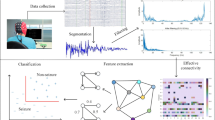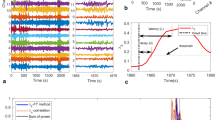Abstract
Epilepsy is a brain network disorder, which may be due to unusual neuron firing in the brain region causes seizures that lead to a loss of consciousness. Patients with epilepsy could benefit considerably from the capacity to precisely predict seizures. The ability to predict seizure activity is dependent on the proper identification of seizure activity precursors from electroencephalography recordings. Considering the fact that a huge list of characteristics has been offered, none of them can independently describe brain states. This method is to study the EEG signal through coherence and phase synchronization measures. Phase Locking Value is computed to measure the phase synchronization. Channel interconnection is accessed through functional connectivity index (FCI) features. The bispectrum measure is proposed to account for both the signal's amplitude and the degree of phase coupling between two frequencies. Thus, this work focuses on implementing a novel FCI based feature that is Bi-Spectral Phase Concurrence Index which exhibits a 3-dimensional frequency triplet mapping of the EEG signal interaction levels. FCI features have been measured through mean magnitude, normalized bi-spectral entropy and normalized squared entropy of the bi-spectrum along with graph theory approach. The bispectrum's quantitative properties were extracted and put through statistical tests to see if there were any significant changes between preictal and interictal recordings. Using all bispectrum-extracted features, the results revealed statistically significant differences (p < 0.05) between preictal and interictal states. The graph theory is also used to analyze the brain connectivity pattern for seizure and on-seizure state. Further, this study analyzes the efficiency and transferability of the proposed model for multi-class tasks with great clinical significance using different electroencephalogram datasets. The average classification accuracy, Specificity and Sensitivity of 99.79%, 100% and 98.6% were respectively are achieved.













Similar content being viewed by others
Availability of Data and Materials
All data generated or analyzed during this study are included in this published article.
References
Florian, M., Andrzejak, R. G., Elger, C. E., & Lehnertz, K. (2007). Seizure prediction: The long and winding road. Brain, 130(2), 314–333.
Nunez Paul, L., Silberstein, R. B., Shi, Z., Carpenter, M. R., Srinivasan, R., Tucker, D. M., Doran, S. M., Cadusch, P. J., & Wijesinghe, R. S. (1999). EEG coherency II: Experimental comparisons of multiple measures. Clinical Neurophysiology, 110(3), 469–486.
Vangelis, S. (2011). Review of advanced techniques for the estimation of brain connectivity measured with EEG/MEG. Computers in Biology and Medicine, 41(12), 1110–1117.
Sharmila, A., & Geethanjali, P. (2016). DWT based detection of epileptic seizure from EEG signals using naive Bayes and k-NN classifiers. IEEE Access, 4, 7716–7727.
Antonakakis, M., Dimitriadis, S. I., Zervakis, M., Micheloyannis, S., Rezaie, R., Babajani-Feremi, A., Zouridakis, G., & Papanicolaou, A. C. (2016). Altered cross-frequency coupling in resting-state MEG after mild traumatic brain injury. International Journal of Psychophysiology, 102, 1–11.
Min, P. K., Cho, K. H., Lee, H.-J., Heo, K., Lee, B. I., & Kim, S. E. (2020). Predicting the antiepileptic drug response by brain connectivity in newly diagnosed focal epilepsy. Journal of Neurology, 4, 1–9.
Ahmadi, A., Davoudi, S., & Daliri, M. R. (2019). Computer Aided Diagnosis System for multiple sclerosis disease based on phase to amplitude coupling in covert visual attention. Computer methods and programs in biomedicine, 169, 9–18.
Alvarado-Rojas, C., Valderrama, M., Fouad-Ahmed, A., Feldwisch-Drentrup, H., Ihle, M., Teixeira, C. A., Sales, F., Schulze-Bonhage, A., Adam, C., Dourado, A., & Charpier, S. (2014). Slow modulations of high-frequency activity (40–140 Hz) discriminate preictal changes in human focal epilepsy. Scientific Reports, 4, 4545.
Ashokkumar, S. R., MohanBabu, G., & Anupallavi, S. (2020). A novel two-band equilateral wavelet filter bank method for an automated detection of seizure from EEG signals. International Journal of Imaging Systems and Technology, 30(4), 978–993.
Ahmadi, A., Behroozi, M., Shalchyan, V., & Daliri, M. R. (2018). Classification of epileptic EEG signals by wavelet based CFC. In 2018 electric electronics, computer science, biomedical engineerings' meeting (EBBT) (pp. 1–4). IEEE.
Ahmadi, A., Shalchyan, V., & Daliri, M. R. (2017). A new method for epileptic seizure classification in EEG using adapted wavelet packets. In 2017 electric electronics, computer science, biomedical engineerings' meeting (EBBT) (pp. 1–4). IEEE.
Dimitriadis, S. I., Laskaris, N. A., Bitzidou, M. P., Tarnanas, I., & Tsolaki, M. N. (2015). A novel biomarker of amnestic MCI based on dynamic cross-frequency coupling patterns during cognitive brain responses. Frontiers in neuroscience, 9, 350.
Salimpour, Y., & Anderson, W. S. (2019). Cross-frequency coupling based neuromodulation for treating neurological disorders. Frontiers in neuroscience, 13, 125.
Myers, M. H., Padmanabha, A., Hossain, G., de Jongh Curry, A. L., & Blaha, C. D. (2016). Seizure prediction and detection via phase and amplitude lock values. Frontiers in Human Neuroscience, 10, 80.
Anupallavi, S., & MohanBabu, G. (2021). A novel approach based on BSPCI for quantifying functional connectivity pattern of the brain’s region for the classification of epileptic seizure. Journal of Ambient Intelligence and Humanized Computing, 12(3), 4037–4047.
Barry, H. (2003). The elusive concept of brain connectivity. NeuroImage, 19(2), 466–470.
Ashokkumar, S. R., Anupallavi, S., Premkumar, M., & Jeevanantham, V. (2021). Implementation of deep neural networks for classifying electroencephalogram signal using fractional S-transform for epileptic seizure detection. International Journal of Imaging Systems and Technology, 31(2), 895–908.
Ahmadi, A., Davoudi, S., Behroozi, M., & Daliri, M. R. (2020). Decoding covert visual attention based on phase transfer entropy. Physiology & Behavior, 222, 112932.
Lopes, M. A., Junges, L., Tait, L., Terry, J. R., Abela, E., Richardson, M. P., & Goodfellow, M. (2020). Computational modelling in source space from scalp EEG to inform presurgical evaluation of epilepsy. Clinical Neurophysiology, 131(1), 225–234.
Musaeus, C. S., Nielsen, M. S., Musaeus, J. S., & Høgh, P. (2020). Electroencephalographic cross-frequency coupling as a sign of disease progression in patients with mild cognitive impairment: A pilot study. Frontiers in Neuroscience, 14, 790.
Jaiswal, A. K., & Banka, H. (2017). Local pattern transformation based feature extraction techniques for classification of epileptic EEG signals. Biomedical Signal Processing and Control, 34, 81–92.
Ashokkumar, S. R., & MohanBabu, G. (2020). Extreme learning adaptive neuro-fuzzy inference system model for classifying the epilepsy using Q-Tuned wavelet transform. Journal of Intelligent & Fuzzy Systems, 39(1), 233–248.
Hossain, M. S., Amin, S. U., Alsulaiman, M., & Muhammad, G. (2019). Applying deep learning for epilepsy seizure detection and brain mapping visualization. ACM Transactions on Multimedia Computing, Communications and Applications (TOMM), 15(1), 1–17.
Ashokkumar, S. R., Anupallavi, S., MohanBabu, G., Premkumar, M., & Jeevanantham, V. (2022). Emotion identification by dynamic entropy and ensemble learning from electroencephalogram signals. International Journal of Imaging Systems and Technology, 32(1), 402–413.
Mormann, F., Lehnertz, K., David, P., & Elger, C. E. (2000). Mean phase coherence as a measure for phase synchronization and its application to the EEG of epilepsy patients. Physica D: Nonlinear Phenomena, 144(3–4), 358–369.
Gerster, M., Berner, R., Sawicki, J., Zakharova, A., Škoch, A., Hlinka, J., Lehnertz, K., & Schöll, E. (2020). FitzHugh–Nagumo oscillators on complex networks mimic epileptic-seizure-related synchronization phenomena. Chaos: An Interdisciplinary Journal of Nonlinear Science, 30(12), 123130.
Imperatori, C., Farina, B., Quintiliani, M. I., Onofri, A., Gattinara, P. C., Lepore, M., et al. (2014). Aberrant EEG functional connectivity and EEG power spectra in resting state post-traumatic stress disorder: A sLORETA study. Biological Psychology, 102, 10–17.
Sharma, M., & Pachori, R. B. (2017). A novel approach to detect epileptic seizures using a combination of tunable-Q wavelet transform and fractal dimension. Journal of Mechanics in Medicine and Biology, 17(07), 1740003.
Abdulla, S., Diykh, M., Alkhafaji, S. K., Greena, J. H., Al-Hadeethi, H., Oudah, A. Y., & Marhoon, H. A. (2022). Determinant of covariance matrix model coupled with AdaBoost classification algorithm for EEG seizure detection. Diagnostics, 12(1), 74.
Hussain, L., Aziz, W., Alowibdi, J. S., Habib, N., Rafique, M., Saeed, S., & Kazmi, S. Z. H. (2017). Symbolic time series analysis of electroencephalographic (EEG) epileptic seizure and brain dynamics with eye-open and eye-closed subjects during resting states. Journal of physiological anthropology, 36(1), 1–12.
Feng, N., Hu, F., Wang, H., & Gouda, M. A. (2020). Decoding of voluntary and involuntary upper-limb motor imagery based on graph fourier transform and cross-frequency coupling coefficients. Journal of Neural Engineering, 17(5), 056043.
Bhattacharyya, A., Pachori, R., Upadhyay, A., & Acharya, U. (2017). Tunable-Q wavelet transform based multiscale entropy measure for automated classification of epileptic EEG signals. Applied Sciences, 7(4), 385.
Raghu, S., Sriraam, N., Hegde, A. S., & Kubben, P. L. (2019). A novel approach for classification of epileptic seizures using matrix determinant. Expert Systems with Applications, 127, 323–341.
Gupta, V., & Pachori, R. B. (2019). Epileptic seizure identification using entropy of FBSE based EEG rhythms. Biomedical Signal Processing and Control, 53(May), 101569.
Hassan, A. R., Subasi, A., & Zhang, Y. (2020). Epilepsy seizure detection using complete ensemble empirical mode decomposition with adaptive noise. Knowledge Based Systems, 191, 105333.
Dash, D. P., & Kolekar, M. H. (2020). Hidden Markov model based epileptic seizure detection using tunable Q wavelet transform. Journal of Biomedical Research, 34(3), 170.
Park, C., Choi, G., Kim, J., Kim, S., Kim, T. J., Min, K., Jung, K. Y., Chong, J. (2018). Epileptic seizure detection for multi-channel EEG with deep convolutional neural network. In ICEIC 2018: IEEE international conference on electronics, information, and communication (pp. 1–5).
Chakraborty Sukriti, M., & Mitra, D. (2021). Epilepsy seizure detection using kurtosis based VMD’s parameters selection and bandwidth features. Biomedical Signal Processing and Control, 64(2020), 102255.
Chandel, G., Upadhyaya, P., Farooq, O., & Khan, Y. U. (2019). Detection of seizure event and its Onset_Offset using orthonormal triadic wavelet based features. IRBM, 40(2), 103–112.
Peng, H., et al. (2021). Automatic epileptic seizure detection via Stein kernel-based sparse representation. Computers in Biology and Medicine, 132, 104338.
Mouleeshuwarapprabu, R., & Kasthuri, N. (2020). Nonlinear vector decomposed neural network based EEG signal feature extraction and detection of seizure. Microprocessors and Microsystems, 76, 103075.
Prathaban, B. P., & Balasubramanian, R. (2020). Prediction of epileptic seizures using grey wolf optimized model driven mathematical approach. Microprocessors and Microsystems. https://doi.org/10.1016/j.micpro.2020.103370
BouAssi, E., Nguyen, D. K., Rihana, S., & Sawan, M. (2017). Towards accurate prediction of epileptic seizures: A review. Biomedical Signal Processing and Control, 34, 144–157.
Robbie Joel, C., Clarke, A. R., Barry, R. J., Dupuy, F. E., McCarthy, R., & Selikowitz, M. (2016). Coherence in children with AD/HD and excess alpha power in their EEG. Clinical Neurophysiology, 127(5), 2161–2166.
Funding
No funding.
Author information
Authors and Affiliations
Contributions
All authors contribute to the concept, the design, and developments of the algorithm and the simulation results in this manuscript. All authors read and approved the final manuscript.
Corresponding author
Ethics declarations
Conflict of interest
The authors declare that they have no conflict of interest.
Additional information
Publisher's Note
Springer Nature remains neutral with regard to jurisdictional claims in published maps and institutional affiliations.
Rights and permissions
Springer Nature or its licensor (e.g. a society or other partner) holds exclusive rights to this article under a publishing agreement with the author(s) or other rightsholder(s); author self-archiving of the accepted manuscript version of this article is solely governed by the terms of such publishing agreement and applicable law.
About this article
Cite this article
Ashokkumar, S.R., Premkumar, M., Anupallavi, S. et al. Quantifying Functional Connectivity Network Through Synchronization and Graph Theory Approaches for Seizure Prediction. Wireless Pers Commun 129, 747–780 (2023). https://doi.org/10.1007/s11277-022-10154-w
Accepted:
Published:
Issue Date:
DOI: https://doi.org/10.1007/s11277-022-10154-w




